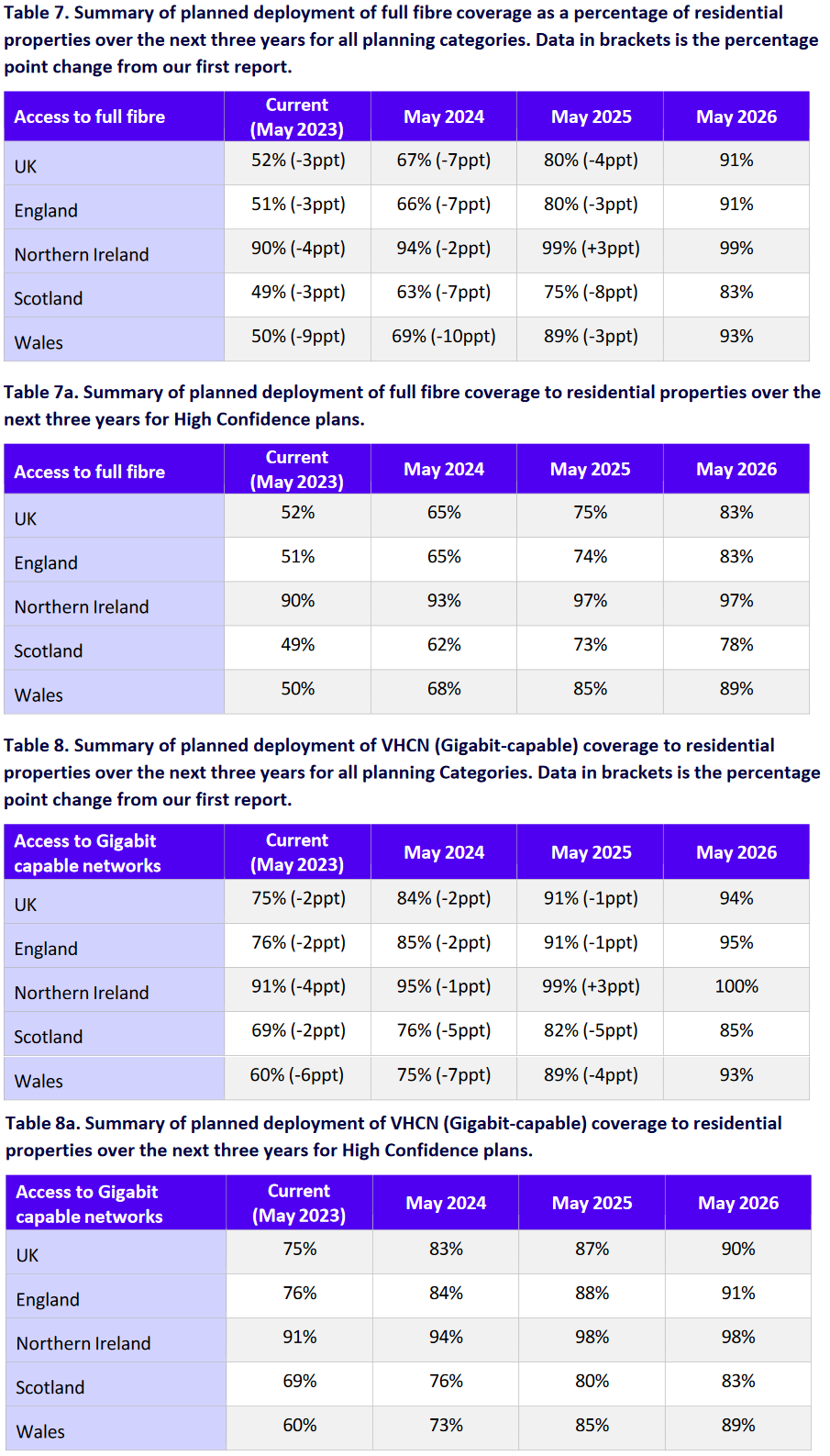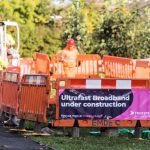Ofcom Predict 94 Percent of UK Covered by Gigabit Broadband in May 2026

Ofcom has today published the latest edition of their forecast for Planned Network Deployments, which predicts that the full fibre (FTTP) broadband ISP lines are on course to cover 91% (27 million premises) of all UK properties by May 2026 – rising to 94% for “gigabit-capable” networks (i.e. FTTP and Cable).
According to the regulator’s latest data to May 2023 (here), some 52% (15.4m) of UK homes are currently within reach of a Fibre-to-the-Premises (FTTP) network (up from 48% in Jan 2023) and this rises to 75% for gigabit-capable networks (up from 73%). The latter is being driven by both FTTP from multiple operators and Virgin Media’s older cable DOCSIS 3.1 network (there’s a lot of overbuild between these in urban areas).
The new report goes further and, based on the stated deployment plans of network operators as of May 2023 (up to 3 years in advance), attempts to predict how much coverage will be achieved by May 2026. These plans include those that are privately funded as well as any plans that are supported through public funds/intervention.
Advertisement
However, the report only focuses on Communications Providers’ (ISPs’) planned deployments and does not take account of any aspirations or plans by public authorities, whether national or local, to roll out networks in their geographical areas. We should add that, so far, the vast majority of FTTP and gigabit-capable coverage has reflected commercial builds – mostly in urban areas – and this will continue until around the 80%+ mark.
Although much of this planned build is focused on urban or suburban areas, rural areas could also see substantial network upgrades. If all planned deployments are realised, Ofcom claims 98% of urban properties would be gigabit-capable by May 2026, up from 81% this year; and 75% of rural properties would be covered, up from 42% in May this year.
All of this also needs to be put within the context of the UK Government’s £5bn Project Gigabit programme, which aims to further improve the picture for gigabit speed connectivity by using state aid to target connectivity improvements toward the final 20% of hardest to reach premises (i.e. helping to extend gigabit coverage to at least 85% of UK premises by the end of 2025 and then around 99% “nationwide” by 2030).
The following forecast splits the figures down across England, Wales, Scotland and Northern Ireland. Ofcom also gives an additional “High Confidence” forecast, which gives a forecast for coverage from plans that have reached both the Low Level Design stage and for which funding has actually been committed (this excludes a lot of highly likely, but not yet 100% committed, build plans).
Advertisement
In a scenario where only the high confidence plans were fully delivered, then the UK would see 83% full fibre coverage by May 2026, rising to 90% for gigabit-capable networks. In both cases, the government’s first 85% target for gigabit-capable coverage would have still been exceeded, but that was never in much doubt due to strong commercial builds. The hardest task is getting to 99%+ by 2030.

Mark is a professional technology writer, IT consultant and computer engineer from Dorset (England), he also founded ISPreview in 1999 and enjoys analysing the latest telecoms and broadband developments. Find me on X (Twitter), Mastodon, Facebook, BlueSky, Threads.net and Linkedin.
« Broadband ISP Ogi Boost Data Capacity to Wales via New Fibre Route





















































Lets hope so as I cant be doing with all those who continually moan about not having full fibre broadband. Lets put this to bed so they can start moaning about something else.
It’ll be the people on first generation BT FTTP (330/50) who’ll be moaning next demanding the next tech step up…but they were lauding over the new tech when they got it.
If you had just ADSL or FTTC or Virgin Media’s HFC then you should understand complaints. VM’s service struggles in a number of areas and in a number doesn’t deliver 1 gig and averages lower around 720-800mbps despite being over provisioned at 1.2gbps and has latency over other FTTP services.
@Barney
Are their that many on the ECI OLT kit? The latest newcomer to openreach FTTP is ADTRAN and I wouldn’t want to use their kit. I am happy with Nokia thank you very much.
guy with FTTP doesn’t like people without FTTP complaining about it.
tough break kid.
ECI is <0.5%. Its barely any.
I'd expect BT to want to upgrade these areas to XGS PON at some point as they push push the prices of lower speed products.
@Sid Why? The Adtran kit is fine.
@anon, you’re making a big assumption there kid.
@sid
What is it you don’t like about Adtran kit?
Why do people think that moaning here will improve their chances of getting full fibre?
@Barney
The GPON network Openreach currently deploys is capable of 2.4Gb down and 1.2Gb up. I imagine for the vast majority of customer’s this will be sufficient for at least The next 10 years. We then probably be ready to make the jump direct to 100G+.
@sid, what difference does it make to you what they use? I presume you mean ONT, more than routers? I have a ADTRAN ONT hanging on the wall behind the TV, I forget it is there most of the time, it is only when I get a problem with my broadband that I look at it just to see if the lights that are supposed to be lit are lit and vice versa.
Changing the router is a different thing, some routers are better than others, my router is far better than the Icotera that my provider supplied. But again, unless you want to do specific things with your router and network, if the router that is supplied works OK, then may as well keep it.
Many people just stick the router in a corner or on a shelf and forget about it. Mind you, I have seen some routers in some strange places, one in an airing cupboard where the hot water tank is, and they wondered why it did not work.
Hope they have modelled in any predicted budget shelving for this aligned to “people getting back to work” or whatever rhetoric the Tories use next.
In my view the Ofcom report should start with
Despite us ….
It’ll be yet another number upon their list of utterly false promises that they incapable of delivering on. I don’t expect a single thing more from them.
Seems to be on track right now.
https://labs.thinkbroadband.com/local/
Openreach released any more exchange coverage update pdfs yet?
I predict they will be wrong
@anon, Yet another finger in the air prediction, may be it could be better used.
@Billy. Thanks for gatekeeping lad. I’ll make sure to ask yer permission next time before I post my thoughts.
@anal, I learnt everything from you.
I agree. They should do the Skegness comedy circuit with them figures!
It’ll be interesting to see how the edge cases are handled. I’m talking, Exchange only lines, street that’s been bypassed by an altnet because the ducts are junk or some of the locals rejected poles or an address where the altnet run out of connections. I’m aware of all three in my locality – Will there be some effort to cover these sites? Its frustrating being in an urban area with sub 30Mb connections but it seems increasingly common and easily missed in the stats (My postcode is covered but I am not!).
Is it April the 1st already? what planet are they on? I get the impression they threw darts at a board of percentages. Hell, the government should put them in charge of HS2 with that sheer volume of optimism!
@Buggerlugz, not to long to wait and see 🙂
So how much will this cost customers that work for a living, and don’t recive any financial support from anybody?
Will it be offered to those that dodge work as well, i.e those suffering with a bad back/ stress or anxiety for free?
You okay, James?
Who gets broadband for free, apart from no doubt politicians as they say they need it for work and some people who get it installed and paid for by their work, but the majority of people have to pay for it.
There are a lot of people who work with anxiety and stress and if you have never had to deal with it, then you are a lucky person, it can creep up on you and bang. The same with backache, if you have never had that, then you are lucky.
I am sure, in fact I know, that there are people saying they have a bad back and yet you see them lugging stuff around that a person with a bad back should never lug around and there are no doubt people saying they are stressed and are not.
the human brain is a strange thing, and we know very little about it or how it works.
Surely what matters is what is currently under construction. I see no point in forecasting what might happen. I suspect that the real purpose of these airy-fairy reports is to justify the continued employment of Ofcom bureaucrats.
We will just wait and see, the Alt networks are helping with this as long as they keep going. I no more have a crystal ball than anyone else, including Ofcom, as my mother used to say, a lot of water will flow under the bridge by then.
If we assume coverage increases at about 0.5% a month that may give a more realistic coverage figure
Lets assume current coverage around 55% we are looking at around 75% to 80% by 2026
Just let me know when LA12 will all get gigabit with same guaranteed minimum speeds,
and when geographic coverage (the less low hanging fruit) will be factually reported rather than the sounds better metropolitan area % ares,
and then of all the implementations what the duplication (waste) / overlapping of competing ‘services’ is and actual in service utilisation is of each original providers infrasturcture (and acquired disparate systems/versions)